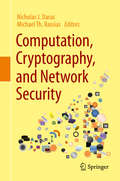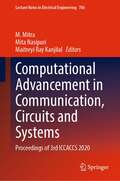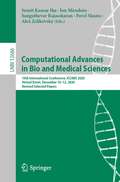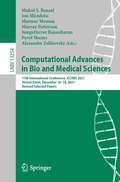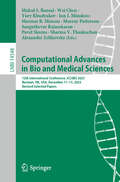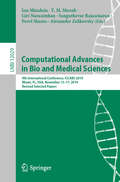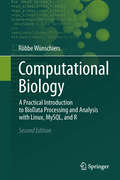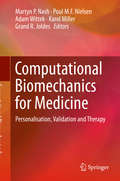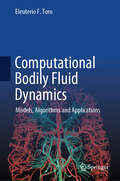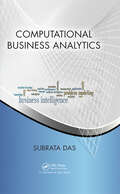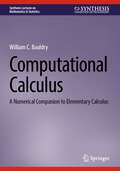- Table View
- List View
Computation of Artificial Intelligence and Machine Learning: First International Conference, ICCAIML 2024, Jaipur, India, January 18–19, 2024, Proceedings, Part II (Communications in Computer and Information Science #2185)
by Milan Tuba Amit Kumar Bairwa Varun Tiwari Santosh Kumar Vishwakarma Thittaporn GanokratanaaThe two-volume set, CCIS 2184-2185, constitutes the refereed proceedings of the First International Conference on Computation of Artificial Intelligence and Machine Learning, ICCAIML 2024, held in Jaipur, India, in January 18–19, 2024. The 60 papers included in these volumes were carefully reviewed and selected from 645 submissions. These papers focus on various subject areas within the field of Artificial Intelligence and Machine Learning, such as Neural Networks and Deep Learning, Natural Language Processing, Computer Vision, Reinforcement Learning, Data Mining and Big Data Analytics, AI in Healthcare and Biomedical Applications, Autonomous Systems and Robotics, AI Ethics and Fairness, AI in Finance and Eco-nomics.
Computation, Cryptography, and Network Security
by Nicholas J. Daras Michael Th. RassiasAnalysis, assessment, and data management are core competencies for operation research analysts. This volume addresses a number of issues and developed methods for improving those skills. It is an outgrowth of a conference held in April 2013 at the Hellenic Military Academy, and brings together a broad variety of mathematical methods and theories with several applications. It discusses directions and pursuits of scientists that pertain to engineering sciences. It is also presents the theoretical background required for algorithms and techniques applied to a large variety of concrete problems. A number of open questions as well as new future areas are also highlighted. This book will appeal to operations research analysts, engineers, community decision makers, academics, the military community, practitioners sharing the current "state-of-the-art," and analysts from coalition partners. Topics covered include Operations Research, Games and Control Theory, Computational Number Theory and Information Security, Scientific Computing and Applications, Statistical Modeling and Applications, Systems of Monitoring and Spatial Analysis.
Computational Advancement in Communication, Circuits and Systems: Proceedings of 3rd ICCACCS 2020 (Lecture Notes in Electrical Engineering #786)
by Maitreyi Ray Kanjilal M. Mitra Mita NasipuriThis book gathers the proceedings of the Third International Conference on Computational Advancement in Communication Circuits and Systems (ICCACCS 2020), organized virtually by Narula Institute of Technology, Kolkata, India. The book presents peer-reviewed papers that highlight new theoretical and experimental findings in the fields of electronics and communication engineering, including interdisciplinary areas like advanced computing, pattern recognition and analysis, and signal and image processing. The respective papers cover a broad range of principles, techniques, and applications in microwave devices, communication and networking, signal and image processing, computations and mathematics, and control.
Computational Advances in Bio and Medical Sciences: 10th International Conference, ICCABS 2020, Virtual Event, December 10-12, 2020, Revised Selected Papers (Lecture Notes in Computer Science #12686)
by Pavel Skums Alex Zelikovsky Sanguthevar Rajasekaran Ion Măndoiu Sumit Kumar JhaThis book constitutes the proceedings of the 10th International Conference on Computational Advances in Bio and Medical Sciences, ICCABS 2020, held in December 2020. Due to COVID-19 pandemic the conference was held virtually.The 6 regular and 5 invited papers presented in this book were carefully reviewed and selected from 16 submissions. The use of high throughput technologies is fundamentally changing the life sciences and leading to the collection of large amounts of biological and medical data. The papers show how the use of this data can help expand our knowledge of fundamental biological processes and improve human health - using novel computational models and advanced analysis algorithms.
Computational Advances in Bio and Medical Sciences: 11th International Conference, ICCABS 2021, Virtual Event, December 16–18, 2021, Revised Selected Papers (Lecture Notes in Computer Science #13254)
by Alexander Zelikovsky Pavel Skums Sanguthevar Rajasekaran Ion Măndoiu Mukul S. Bansal Marmar Moussa Murray PattersonThis book constitutes revised selected papers from the refereed proceedings of the 11th International Conference on Computational Advances in Bio and Medical Sciences, ICCABS 2021, held as a virtual event during December 16–18, 2021.The 13 full papers included in this book were carefully reviewed and selected from 17 submissions. They were organized in topical sections as follows: Computational advances in bio and medical sciences; and computational advances in molecular epidemiology.
Computational Advances in Bio and Medical Sciences: 12th International Conference, ICCABS 2023, Norman, OK, USA, December 11–13, 2023, Revised Selected Papers (Lecture Notes in Computer Science #14548)
by Wei Chen Alexander Zelikovsky Pavel Skums Sanguthevar Rajasekaran Yury Khudyakov Sharma V. Thankachan Mukul S. Bansal Murray Patterson Ion I. Măndoiu Marmar R. MoussaThis book constitutes the refereed proceedings of the 12th International Conference on Computational Advances in Bio and Medical Sciences, ICCABS 2023, held in Norman, Oklahoma, USA, during December 11–13, 2023. The 23 full papers included in this book were carefully reviewed and selected from 65 submissions. These papers focus on the recent advances in Computational techniques and applications in the areas of Biology, Medicine, and Drug discovery.
Computational Advances in Bio and Medical Sciences: 9th International Conference, ICCABS 2019, Miami, FL, USA, November 15–17, 2019, Revised Selected Papers (Lecture Notes in Computer Science #12029)
by Alexander Zelikovsky Pavel Skums Sanguthevar Rajasekaran Ion Măndoiu T. M. Murali Giri NarasimhanThis book constitutes revised selected papers from the 9th International Conference on Computational Advances in Bio and Medical Sciences, ICCABS 2019, held in Miami, Florida, USA in November 2019.The 15 papers presented in this volume were carefully reviewed and selected from 30 submissions. They deal with topics such as computational biology; biomedical image analysis; biological networks; cancer genomics; gene enrichment analysis; functional genomics; interaction networks; protein structure prediction; dynamic programming; and microbiome analysis.
Computational Advertising: Market and Technologies for Internet Commercial Monetization
by Peng Liu Chao WangThis book introduces computational advertising, and Internet monetization. It provides a macroscopic understanding of how consumer products in the Internet era push user experience and monetization to the limit. Part One of the book focuses on the basic problems and background knowledge of online advertising. Part Two targets the product, operations, and sales staff, as well as high-level decision makers of the Internet products. It explains the market structure, trading models, and the main products in computational advertising. Part Three targets systems, algorithms, and architects, and focuses on the key technical challenges of different advertising products. Features · Introduces computational advertising and Internet monetization · Covers data processing, utilization, and trading · Uses business logic as the driving force to explain online advertising products and technology advancement · Explores the products and the technologies of computational advertising, to provide insights on the realization of personalization systems, constrained optimization, data monetization and trading, and other practical industry problems · Includes case studies and code snippets
Computational Analysis and Deep Learning for Medical Care: Principles, Methods, and Applications
by Amit Kumar TyagiThis book discuss how deep learning can help healthcare images or text data in making useful decisions”. For that, the need of reliable deep learning models like Neural networks, Convolutional neural network, Backpropagation, Recurrent neural network is increasing in medical image processing, i.e., in Colorization of Black and white images of X-Ray, automatic machine translation, object classification in photographs / images (CT-SCAN), character or useful generation (ECG), image caption generation, etc. Hence, Reliable Deep Learning methods for perception or producing belter results are highly effective for e-healthcare applications, which is the challenge of today. For that, this book provides some reliable deep leaning or deep neural networks models for healthcare applications via receiving chapters from around the world. In summary, this book will cover introduction, requirement, importance, issues and challenges, etc., faced in available current deep learning models (also include innovative deep learning algorithms/ models for curing disease in Medicare) and provide opportunities for several research communities with including several research gaps in deep learning models (for healthcare applications).
Computational Analysis of Sound Scenes and Events
by Tuomas Virtanen Mark D. Plumbley Dan EllisThis book presents computational methods for extracting the useful information from audio signals, collecting the state of the art in the field of sound event and scene analysis. The authors cover the entire procedure for developing such methods, ranging from data acquisition and labeling, through the design of taxonomies used in the systems, to signal processing methods for feature extraction and machine learning methods for sound recognition. The book also covers advanced techniques for dealing with environmental variation and multiple overlapping sound sources, and taking advantage of multiple microphones or other modalities. The book gives examples of usage scenarios in large media databases, acoustic monitoring, bioacoustics, and context-aware devices. Graphical illustrations of sound signals and their spectrographic representations are presented, as well as block diagrams and pseudocode of algorithms.
Computational Analysis of Terrorist Groups: Lashkar-e-taiba
by Amy Sliva V. S. Subrahmanian John P. Dickerson Jana Shakarian Aaron MannesComputational Analysis of Terrorist Groups: Lashkar-e-Taiba provides an in-depth look at Web intelligence, and how advanced mathematics and modern computing technology can influence the insights we have on terrorist groups. This book primarily focuses on one famous terrorist group known as Lashkar-e-Taiba (or LeT), and how it operates. After 10 years of counter Al Qaeda operations, LeT is considered by many in the counter-terrorism community to be an even greater threat to the US and world peace than Al Qaeda. Computational Analysis of Terrorist Groups: Lashkar-e-Taiba is the first book that demonstrates how to use modern computational analysis techniques including methods for "big data" analysis. This book presents how to quantify both the environment in which LeT operate, and the actions it took over a 20-year period, and represent it as a relational database table. This table is then mined using sophisticated data mining algorithms in order to gain detailed, mathematical, computational and statistical insights into LeT and its operations. This book also provides a detailed history of Lashkar-e-Taiba based on extensive analysis conducted by using open source information and public statements. Each chapter includes a case study, as well as a slide describing the key results which are available on the authors' web sites. Computational Analysis of Terrorist Groups: Lashkar-e-Taiba is designed for a professional market composed of government or military workers, researchers and computer scientists working in the web intelligence field. Advanced-level students in computer science will also find this valuable as a reference book.
Computational Approaches in the Transfer of Aesthetic Values from Paintings to Photographs: Beyond Red, Green and Blue
by Xiaoyan Zhang Martin Constable Kap Luk Chan Jinze Yu Wang JunyanThis book examines paintings using a computational and quantitative approach. Specifically, it compares paintings to photographs, addressing the strengths and limitations of both. Particular aesthetic practices are examined such as the vista, foreground to background organisation and the depth planes. These are analysed using a range of computational approaches and clear observations are made. New generations of image-capture devices such as Google goggles and the light field camera, promise a future in which the formal attributes of a photograph are made available for editing to a degree that has hitherto been the exclusive territory of painting. In this sense paintings and photographs are converging, and it therefore seems an opportune time to study the comparisons between them. In this context, the book includes cutting-edge work examining how some of the aesthetic attributes of a painting can be transferred to a photograph using the latest computational approaches.
Computational Approaches to the Network Science of Teams
by Hanghang Tong Liangyue LiBusiness operations in large organizations today involve massive, interactive, and layered networks of teams and personnel collaborating across hierarchies and countries on complex tasks. To optimize productivity, businesses need to know: what communication patterns do high-performing teams have in common? Is it possible to predict a team's performance before it starts work on a project? How can productive team behavior be fostered? This comprehensive review for researchers and practitioners in data mining and social networks surveys recent progress in the emerging field of network science of teams. Focusing on the underlying social network structure, the authors present models and algorithms characterizing, predicting, optimizing, and explaining team performance, along with key applications, open challenges, and future trends.
Computational Artificial Intelligence and Methods for industries: A Machine-Generated Literature Overview
by Vijayarangan NatarajanThis book presents the result of an innovative challenge, to create a systematic literature overview driven by machine-generated content. Questions and related keywords were prepared for the machine to query, discover, collate and structure by Artificial Intelligence (AI) clustering. The AI-based approach seemed especially suitable to provide an innovative perspective as the topics are indeed both complex, interdisciplinary and multidisciplinary, for example, climate, planetary and evolution sciences. Springer Nature has published much on these topics in its journals over the years, so the challenge was for the machine to identify the most relevant content and present it in a structured way that the reader would find useful. The automatically generated literature summaries in this book are intended as a springboard to further discoverability. They are particularly useful to readers with limited time, looking to learn more about the subject quickly and especially if they are new to the topics. Springer Nature seeks to support anyone who needs a fast and effective start in their content discovery journey, from the undergraduate student exploring interdisciplinary content to Master- or PhD-thesis developing research questions, to the practitioner seeking support materials, this book can serve as an inspiration, to name a few examples. It is important to us as a publisher to make the advances in technology easily accessible to our authors and find new ways of AI-based author services that allow human-machine interaction to generate readable, usable, collated, research content.
Computational Bayesian Statistics: An Introduction (Institute of Mathematical Statistics Textbooks #11)
by Carlos Daniel Paulino Peter Müller M. Antónia Amaral TurkmanMeaningful use of advanced Bayesian methods requires a good understanding of the fundamentals. This engaging book explains the ideas that underpin the construction and analysis of Bayesian models, with particular focus on computational methods and schemes. The unique features of the text are the extensive discussion of available software packages combined with a brief but complete and mathematically rigorous introduction to Bayesian inference. The text introduces Monte Carlo methods, Markov chain Monte Carlo methods, and Bayesian software, with additional material on model validation and comparison, transdimensional MCMC, and conditionally Gaussian models. The inclusion of problems makes the book suitable as a textbook for a first graduate-level course in Bayesian computation with a focus on Monte Carlo methods. The extensive discussion of Bayesian software - R/R-INLA, OpenBUGS, JAGS, STAN, and BayesX - makes it useful also for researchers and graduate students from beyond statistics.
Computational Biology of Non-Coding RNA: Methods and Protocols (Methods in Molecular Biology #1912)
by Julio Vera Xin Lai Shailendra K. GuptaThis volume details a collection of state-of-art methods including identification of novel ncRNAs and their targets, functional annotation and disease association in different biological contexts. Chapters guide readers through an overview of disease-specific ncRNAs, computational methods and workflows for ncRNA discovery, annotation based on high-throughput sequencing data, bioinformatics tools and databases for ncRNA analyses, network-based methods, and kinetic modelling of ncRNA-mediated gene regulation. Written in the highly successful Methods in Molecular Biology series format, chapters include introductions to their respective topics, lists of the necessary materials and reagents, step-by-step, readily reproducible laboratory protocols, and tips on troubleshooting and avoiding known pitfalls. Authoritative and cutting-edge, Computational Biology of Non-Coding RNA: Methods and Protocols aims to provide a state-of-the-art collection of computational methods and approaches that will be of value to researchers interested in ncRNA field.
Computational Biology: A Practical Introduction to Bio Data Juggling with Worked Examples
by Röbbe WünschiersThis extensively expanded third edition offers a practical introduction to Bio Data Science. With a hands-on approach to learning, this book offers ample opportunities to practice: - Installing and utilizing Linux as a virtual machine or remotely - Processing bio data with the programming language AWK - Managing data with the relational database system MariaDB - Analyzing and visualizing data with R - Implementing good bioinformatics practices with Jupyter Notebook and GitHub This book targets both students and professionals in the life sciences. While it is aimed at beginners, it also provides valuable tips and tricks for experienced researchers dealing with large datasets. Worked examples illustrate how to utilize various bioinformatics tools such as BLAST, Clustal, PLINK, IGV, SAMtools, BCFtools, Mason2, Minimap, NCBI Datasets, Velvet, Jmol, and more for: - Identifying bacterial proteins potentially associated with pathogenicity - Querying molecular structures for redox-regulated enzymes - Mapping and assembling real or simulated sequence reads - Identifying and mapping molecular structure mutations in viruses - Conducting genome-wide association studies All software tools and datasets mentioned are freely available, and all code is accessible as Jupyter Notebooks on GitHub. Drawing from the author's experiences and knowledge gained from both academia and industry, this book provides a practical and comprehensive approach to bioinformatics.
Computational Biology: A Practical Introduction to BioData Processing and Analysis with Linux, MySQL, and R
by Röbbe WünschiersThis greatly expanded 2nd edition provides a practical introduction to - data processing with Linux tools and the programming languages AWK and Perl- data management with the relational database system MySQL, and- data analysis and visualization with the statistical computing environment R for students and practitioners in the life sciences. Although written for beginners, experienced researchers in areas involving bioinformatics and computational biology may benefit from numerous tips and tricks that help to process, filter and format large datasets. Learning by doing is the basic concept of this book. Worked examples illustrate how to employ data processing and analysis techniques, e.g. for - finding proteins potentially causing pathogenicity in bacteria, - supporting the significance of BLAST with homology modeling, or- detecting candidate proteins that may be redox-regulated, on the basis of their structure.All the software tools and datasets used are freely available. One section is devoted to explaining setup and maintenance of Linux as an operating system independent virtual machine. The author's experiences and knowledge gained from working and teaching in both academia and industry constitute the foundation for this practical approach.
Computational Biology: A Statistical Mechanics Perspective, Second Edition (Chapman & Hall/CRC Computational Biology Series)
by Ralf BlosseyComputational biology has developed rapidly during the last two decades following the genomic revolution which culminated in the sequencing of the human genome. More than ever it has developed into a field which embraces computational methods from different branches of the exact sciences: pure and applied mathematics, computer science, theoretical physics. This Second Edition provides a solid introduction to the techniques of statistical mechanics for graduate students and researchers in computational biology and biophysics. Material has been reorganized to clarify equilbrium and nonequilibrium aspects of biomolecular systems Content has been expanded, in particular in the treatment of the electrostatic interactions of biomolecules and the application of non-equilibrium statistical mechanics to biomolecules New network-based approaches for the study of proteins are presented. All treated topics are put firmly in the context of the current research literature, allowing the reader to easily follow an individual path into a specific research field. Exercises and Tasks accompany the presentations of the topics with the intention of enabling the readers to test their comprehension of the developed basic concepts.
Computational Biomechanics for Medicine: Models, Algorithms And Implementation
by Poul M.F. Nielsen Karol MillerMathematical modelling and computer simulation have proved tremendously successful in engineering. One of the greatest challenges for mechanists is to extend the success of computational mechanics to fields outside traditional engineering, in particular to biology, biomedical sciences, and medicine. The proposed workshop will provide an opportunity for computational biomechanics specialists to present and exchange opinions on the opportunities of applying their techniques to computer-integrated medicine. For example, continuum mechanics models provide a rational basis for analysing biomedical images by constraining the solution to biologically reasonable motions and processes. Biomechanical modelling can also provide clinically important information about the physical status of the underlying biology, integrating information across molecular, tissue, organ, and organism scales. The main goal of this workshop is to showcase the clinical and scientific utility of computational biomechanics in computer-integrated medicine.
Computational Biomechanics for Medicine: Personalisation, Validation and Therapy
by Karol Miller Adam Wittek Poul M. F. Nielsen Grand R. Joldes Martyn P. NashThis book contains contributions from computational biomechanics specialists who present and exchange opinions on the opportunities for applying their techniques to computer-integrated medicine, including computer-aided surgery and diagnostic systems. Computational Biomechanics for Medicine collects peer-reviewed chapters from the annual Computational Biomechanics for Medicine Workshop, in conjunction with the Medical Image Computing and Computer Assisted Intervention [MICCAI] Society conference. The works are dedicated to research in the field of methods and applications of computational biomechanics to medical image analysis, image-guided surgery, surgical simulation, surgical intervention planning, disease diagnosis and prognosis, analysis of injury mechanisms, implant and prosthesis design, artificial organ design, and medical robotics. These chapters will appeal to a wide range of researchers and students within the fields of engineering and medicine, as well as those working in computational science.
Computational Biomechanics for Medicine: Solid and Fluid Mechanics for the Benefit of Patients
by Karol Miller Adam Wittek Poul M. F. Nielsen Grand Joldes Martyn P. NashComputational Biomechanics for Medicine: Solid and fluid mechanics for the benefit of patients contributions and papers from the MICCAI Computational Biomechanics for Medicine Workshop help in conjunction with Medical Image Computing and Computer Assisted Intervention conference (MICCAI 2019) in Shenzhen, China. The content is dedicated to research in the field of methods and applications of computational biomechanics to medical image analysis, image-guided surgery, surgical simulation, surgical intervention planning, disease prognosis and diagnostics, analysis of injury mechanisms, implant and prostheses design, as well as artificial organ design and medical robotics. These proceedings appeal to researchers, students and professionals in the field.
Computational Bodily Fluid Dynamics: Models, Algorithms and Applications
by Eleuterio F. ToroThis book provides fundamental information on all aspects of computational haemodynamics in an integrated manner, combining physiology, fluid mechanics, differential equations and related numerical methods, computing, experiments and cardiovascular pathologies. Further, it demonstrates how to develop mathematical models for blood and other physiological fluids, such as cerebrospinal fluid, all in the context of research on cardiovascular and neurodegenerative diseases. The book is based on two Master&’s courses and a PhD Winter School course taught at the University of Trento, Italy. Its target audience includes Master&’s students and PhD researchers in engineering, mathematics, computer science, and medicine, but it will also benefit medical professionals, researchers and academics.
Computational Business Analytics (Chapman & Hall/CRC Data Mining and Knowledge Discovery Series #34)
by Subrata DasThis book presents tools and techniques for descriptive, predictive, and prescriptive analytics applicable across multiple domains. The author first covers core descriptive and inferential statistics for analytics and then enhances numerical statistical techniques with symbolic artificial intelligence and machine learning techniques for richer predictive and prescriptive analytics. Through many examples and challenging case studies from a variety of fields, practitioners easily see the connections to their own problems and can then formulate their own solution strategies.
Computational Calculus: A Numerical Companion to Elementary Calculus (Synthesis Lectures on Mathematics & Statistics)
by William C. BauldryThis book offers readers the methods that are necessary to apply the power of calculus to analyze real problems. While most calculus textbooks focus on formula-based calculus, this book explains how to do the analysis of calculus, rates of change, and accumulation from data. The author’s introductory approach prepares students with the techniques to handle numerically-based problems in more advanced classes or in real-world applications. This self-contained book uses the computer algebra system Maple for computation, and the material is easily adaptable for calculators or other computer algebra systems. The author includes historical context and example exercises throughout the book in order to provide readers with a thorough understanding of the topic. This book:Prepares students with the techniques to handle numerically-based problems in in real-world applicationsProvides historical context and example exercises to give a thorough understanding of the topicUtilizes Maple for computation and is adaptable for calculators or other computer algebra systems

